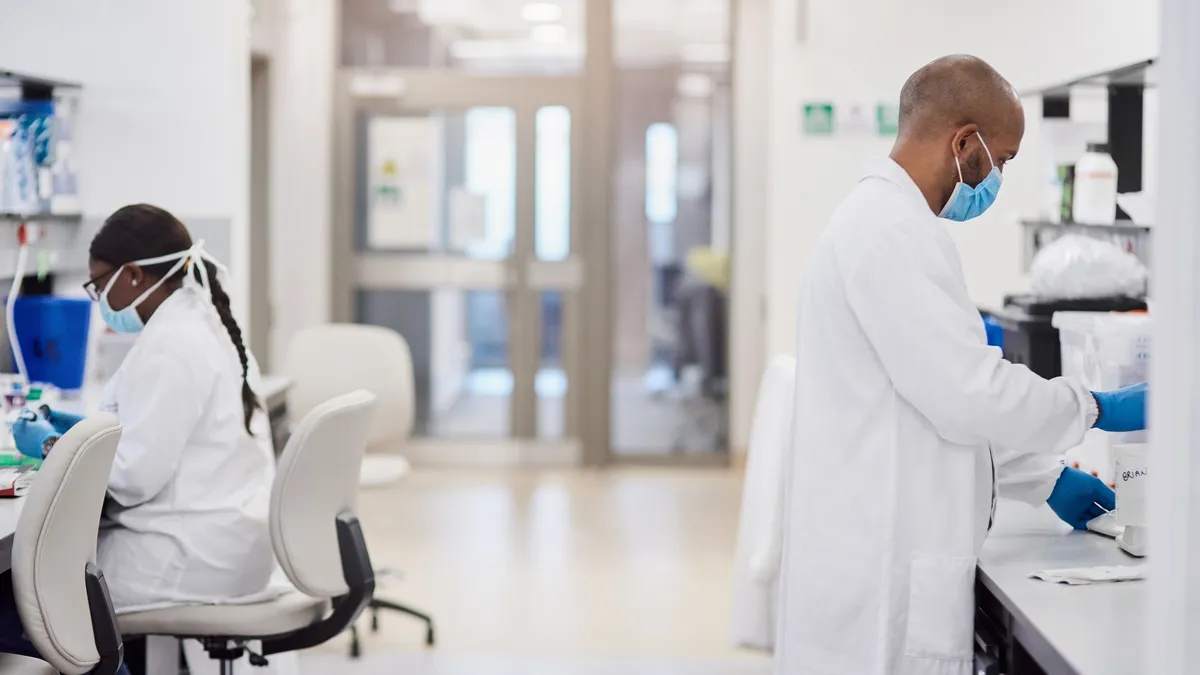As the market for cell and gene therapies gains steam — the FDA is expected to approve as many as 12 new treatments in 2023 — workforce shortages caused by a lack of adequate entry-level training in areas like manufacturing are straining development in the space. And without increased investment from industry and academia in new education programs, experts warn that the promise of the technology to treat large patient populations could be stunted.
Already, industry leaders are having trouble filling positions. In a recent report by the Alliance for Regenerative Medicine, most respondents said they have more than six open roles and an average talent search timeline of two to three months.
The problem is most acute in technical laboratory, manufacturing and quality control positions, where more staff is needed to scale up cell and gene therapy production. While all FDA-approved therapies in the space are currently used to treat rare diseases, nearly 60% of ongoing clinical trials are testing applications for more prevalent disorders, the Alliance’s report found. And as these drugs progress through the pipeline and potentially enter the market, companies will need to ramp up production to meet the larger demand.
Natalie Fekete, manager of science and industry affairs at the Alliance, argued that the workforce bottleneck “speaks to the rapidness of the evolution that's taking place in cell and gene therapy.”

“Because the industry is still growing and maturing, you can expect to see new equipment, new ways of automated processes and data collection, and all of these topics need a new way of teaching as well,” Fekete, who co-authored the Alliance’s report, said.
But because complexities and technical modalities in cell and gene therapy production require additional training beyond what’s needed for other areas of drug development, most existing training programs aren’t preparing students to enter the space.
“There are a few initiatives — basically community colleges — that are providing credentialed training,” Fekete said, noting that it’s far from widespread. And the ones that do provide training often need to update their curriculum on “a yearly or bi-yearly basis to keep up with the new technologies.”
To create a more robust pipeline of workers for the future, more partnerships between industry and academic institutions are needed, and current collaborations could provide a framework to get there.
Local training programs
One idea gaining traction is the creation of a national biotechnician credential program that could be implemented at training centers around the U.S. The Biotechnician Assistant Credentialing Exam, an industry-recognized assessment launched in 2012 by the University of Florida, is being touted as a potential standardized test on which to base a program, as it’s already approved in 12 states and the District of Columbia.
But researchers and leaders in the field have expressed skepticism about the feasibility and utility of a national standard.
“It would be really hard to come up with a national curriculum because not all institutions, whether they be high school, or colleges and universities, are going to have the same resources to carry that out,” said Kristy Shuda McGuire, dean of biomedical studies at The Wistar Institute in Philadelphia. “They also don't all have the same needs.”

In 2000, Wistar began a Biomedical Technician Training program in partnership with the Community College of Philadelphia to allow students at different academic stages to prepare for careers as laboratory technicians, and eventually apprentice in industry facilities. Since then, the program has grown to include community college students from across the state but is still one of only a few programs of its kind in the U.S.
The local focus is key to the program’s success, McGuire said. While the academic portions of the program are meant to provide students with a “solid foundation” in biomedical laboratory skills, the integrated internships at area biotechs like Chimeron Bio and Integral Molecular give students more targeted skills that often lead directly to jobs at the companies.
The program’s structure helps solve one of the key challenges of training regenerative medicine technicians that a nationalized curriculum likely wouldn’t account for — the varying techniques and skills required by each drug developer to create individual products.
“When we talk about workforce development, it's very local,” McGuire argued. “You've got to make sure the training that you're offering is meeting the needs of the employers in your area. People from Philadelphia don't really want to leave Philadelphia, so we've always been training a workforce that is going to stay in the region.”
Industry partnership
The local approach may also allow biopharma companies to create more hands-on partnerships with academic institutions that could lead to direct pipelines of highly specialized talent. For instance, Fekete suggested that a company could reach out to schools in its area, offer funding, and ask for specific skills or disciplines to be taught
Wistar implements a version of that strategy and views it as a win-win situation, McGuire said, because it allows them to seek advice from industry experts and gives their internship partners piece of mind that students will be trained in the skills they need. Its workforce council, which includes industry partners, meets quarterly to update the training structure and curriculum as needed.
"You've got to make sure that the training that you're offering is meeting the needs of the employers in your area."

Kristy Shuda McGuire
Dean of biomedical studies, The Wistar Institute
And when sussing out new partnerships McGuire cautioned that Wistar avoids any company with large bureaucratic processes that require “lots of input from legal” to get anything done. Often that’s led to more partnerships with smaller pharma companies.
On the opposite side, academic and government institutions lack the highly-trained faculty needed to educate the next generation of students because of the low pay rates compared to industry positions.
Precigen, a clinical-stage biopharma focused on immuno-oncology, created a unique postdoc program with the potential to help address this problem. Students who enter the program are given direct access to the company’s immuno-oncology and autoimmune drug development platforms and after the fellowship become eligible for a grant from Precigen to continue their research in academia.
“It becomes very important that the industry and academia come together and play a role in putting some of these programs in place and creating these bridges,” Precigen CEO Helen Sabzevari said. “One without the other, and we will not be serving the patients correctly.”
The retention of existing talent is another issue the industry faces, Fekete said. Once trained workers enter the field, it’s up to the company to create a meaningful environment where they can grow.
“It needs to be clear that this is an industry that's growing, that there are opportunities for growth, and to keep the career path interesting inside the companies that they're working with,” Fekete said. “That's where company culture can be really helpful in driving motivation for each and every individual that is working there.”










